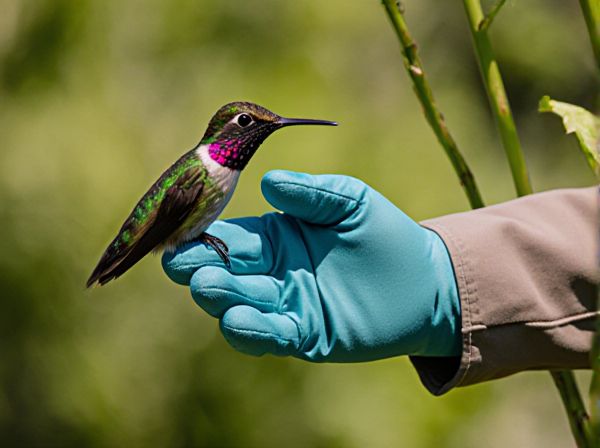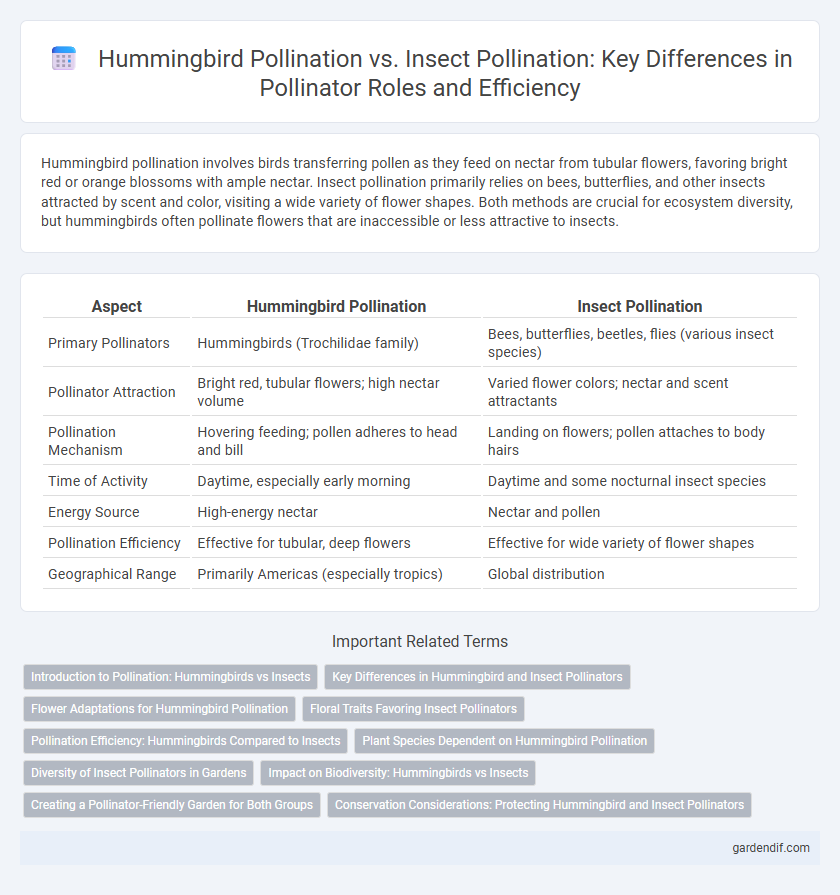
Hummingbird Pollination vs Insect Pollination Illustration
Hummingbird pollination involves birds transferring pollen as they feed on nectar from tubular flowers, favoring bright red or orange blossoms with ample nectar. Insect pollination primarily relies on bees, butterflies, and other insects attracted by scent and color, visiting a wide variety of flower shapes. Both methods are crucial for ecosystem diversity, but hummingbirds often pollinate flowers that are inaccessible or less attractive to insects.
Table of Comparison
| Aspect | Hummingbird Pollination | Insect Pollination |
|---|---|---|
| Primary Pollinators | Hummingbirds (Trochilidae family) | Bees, butterflies, beetles, flies (various insect species) |
| Pollinator Attraction | Bright red, tubular flowers; high nectar volume | Varied flower colors; nectar and scent attractants |
| Pollination Mechanism | Hovering feeding; pollen adheres to head and bill | Landing on flowers; pollen attaches to body hairs |
| Time of Activity | Daytime, especially early morning | Daytime and some nocturnal insect species |
| Energy Source | High-energy nectar | Nectar and pollen |
| Pollination Efficiency | Effective for tubular, deep flowers | Effective for wide variety of flower shapes |
| Geographical Range | Primarily Americas (especially tropics) | Global distribution |
Introduction to Pollination: Hummingbirds vs Insects
Hummingbird pollination involves birds using their long beaks to extract nectar from tubular flowers, facilitating pollen transfer predominantly among brightly colored, tubular blooms adapted to bird vision. Insect pollination, by contrast, features a diverse range of species such as bees, butterflies, and beetles that visit flowers to collect nectar or pollen, enabling cross-pollination among a wide variety of floral shapes and colors. Both mechanisms are crucial for ecosystem health, supporting plant reproduction and biodiversity through specialized adaptations in pollinator behavior and flower morphology.
Key Differences in Hummingbird and Insect Pollinators
Hummingbird pollination relies on vibrant, tubular flowers with abundant nectar, attracting birds with high energy needs and specialized beaks for deep nectar access, whereas insect pollination primarily involves a diverse range of flower shapes and scents that cater to bees, butterflies, and beetles using their legs and body hairs to transfer pollen. Hummingbirds are diurnal and forage over larger areas, facilitating long-distance pollen transfer, while many insect pollinators exhibit both diurnal and nocturnal activity patterns and tend to focus on localized flower patches. The physical interaction in hummingbird pollination tends to be more precise due to the bird's hovering behavior, contrasting with the often broader, brush-like pollen distribution by insects.
Flower Adaptations for Hummingbird Pollination
Flower adaptations for hummingbird pollination include tubular shapes, bright red or orange hues, and the production of abundant, diluted nectar tailored to attract and sustain hummingbirds. These flowers often lack strong scents since hummingbirds rely on sight rather than smell to locate food sources. Sturdy, upright floral structures accommodate hovering feeding behavior, ensuring effective pollen transfer during hummingbird visits.
Floral Traits Favoring Insect Pollinators
Floral traits favoring insect pollinators include bright colors such as yellow, blue, and ultraviolet patterns that attract bees and butterflies, along with sweet fragrances designed to lure insects. Flowers adapted to insect pollination often have landing platforms and produce abundant nectar to facilitate efficient foraging. In contrast to hummingbird-pollinated flowers, insect-pollinated species typically have smaller, less tubular corollas and higher pollen accessibility.
Pollination Efficiency: Hummingbirds Compared to Insects
Hummingbirds exhibit higher pollination efficiency than many insects due to their ability to travel longer distances and visit numerous flowers rapidly, promoting cross-pollination. Their unique hovering flight allows precise pollen transfer on specialized floral structures, enhancing reproductive success in plants adapted to bird pollination. Insects like bees and butterflies contribute significantly to pollination but often have more limited foraging ranges and pollen loads compared to hummingbirds.
Plant Species Dependent on Hummingbird Pollination
Plant species such as trumpet vine (Campsis radicans), columbine (Aquilegia spp.), and various types of fuchsia rely heavily on hummingbird pollination due to their bright tubular flowers and abundant nectar. These plants have evolved traits like vibrant red or orange hues and lack of strong scent, which specifically attract hummingbirds rather than insects. Unlike insect-pollinated species that often depend on scent and landing platforms, hummingbird-pollinated plants prioritize visual cues and nectar accessibility to ensure effective pollination by these specialized birds.
Diversity of Insect Pollinators in Gardens
Insect pollination in gardens supports a diverse range of species, including bees, butterflies, beetles, and flies, each contributing uniquely to plant reproduction and ecosystem health. This diversity enhances pollination efficiency and resilience, as different insect pollinators adapt to various floral structures and environmental conditions. Compared to hummingbird pollination, insect pollinators offer greater versatility in garden ecosystems, promoting biodiversity and sustainable plant growth.
Impact on Biodiversity: Hummingbirds vs Insects
Hummingbird pollination enhances biodiversity by promoting gene flow among specialized, tubular flowers adapted for bird visitation, supporting unique plant species that rely on their long beaks. Insect pollination, involving diverse species like bees, butterflies, and beetles, contributes to a broader range of plant reproduction across various habitats, fostering ecosystem resilience. The complementary roles of hummingbirds and insects ensure comprehensive pollination coverage, vital for maintaining floral diversity and ecosystem stability.
Creating a Pollinator-Friendly Garden for Both Groups
Hummingbird pollination thrives in gardens with tubular red, orange, or pink flowers rich in nectar, while insect pollination favors diverse blooms with accessible pollen and nectar across various colors. Incorporate native plants such as trumpet vine and bee balm to attract hummingbirds, alongside wildflowers and herbs like lavender and coneflower that support bees and butterflies. Ensuring a continuous bloom cycle, water sources, and pesticide-free zones creates an ideal habitat, maximizing pollination efficiency and biodiversity.
Conservation Considerations: Protecting Hummingbird and Insect Pollinators
Hummingbird pollination and insect pollination both play critical roles in maintaining biodiversity and ecosystem health, requiring targeted conservation strategies to protect their habitats and food sources. Preserving native flowering plants and minimizing pesticide use helps support the survival of hummingbirds and pollinating insects such as bees and butterflies. Conservation efforts should prioritize creating pollinator-friendly environments that ensure sustainable populations and promote pollination services essential for agricultural productivity and wild plant reproduction.
Hummingbird Pollination vs Insect Pollination Infographic

 gardendif.com
gardendif.com